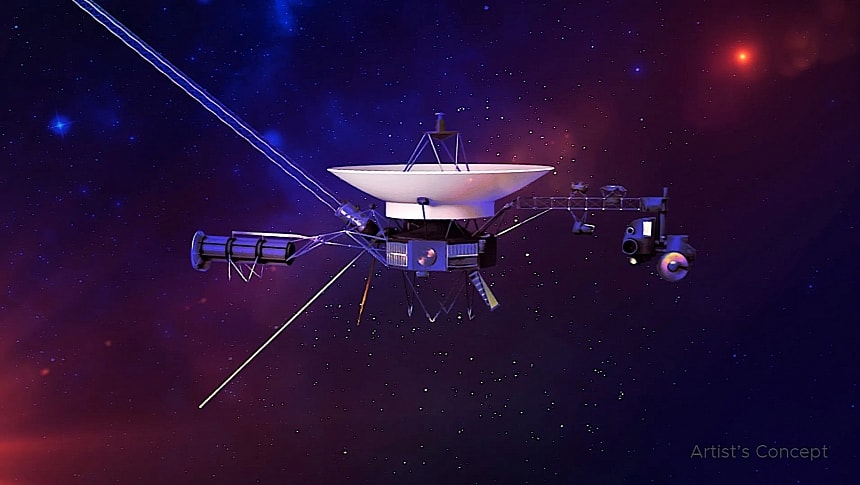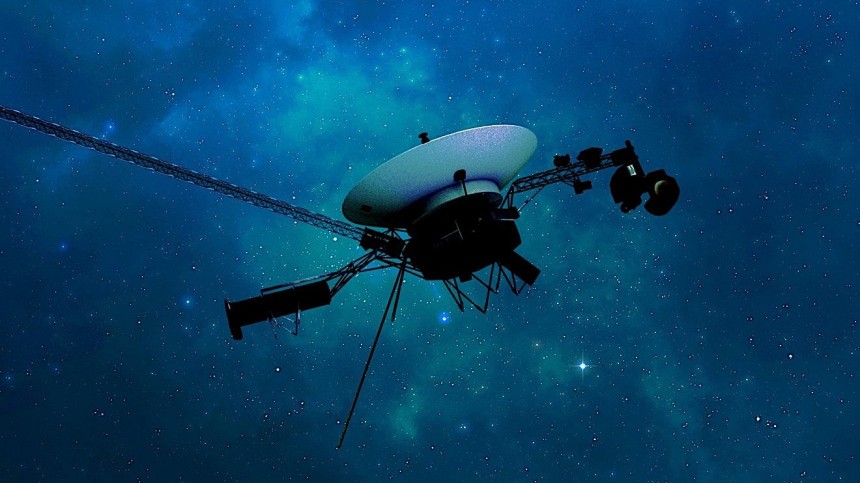Humanity has been at it sending spacecraft into the solar system for decades now. In fact, we've been doing it so long and so intensely that it's unlikely anyone knows exactly how many human-made objects are out there right now – estimates put the number at around 15,000. But we do know a lot of other things about these things, including where the two most distant Earth-made spacecraft are.
The only two ships out of the total of around 15,000 that were launched to have left our solar system are the Voyager 1 and 2. Launched in the 1970s in reverse order (Voyager 2 departed a month before Voyager 1), the two spaceships were intended to take a very close look at two of the biggest planets in our solar system, Jupiter and Saturn.
The initial duration of the Voyager missions was only five years, and the ships were technically not supposed to venture further into space after that. Yet, as mission control began realizing how sturdy these things were, they were sent further and further out into space, to Uranus and Neptune, and later all the way to the heliosphere.
That's the term scientists use to call the boundary separating our solar system from interstellar space. It is the farthest place the Sun's solar wind can reach before being stopped by the interstellar environment, the place humanity will need to cross if it plans on ever becoming truly interstellar.
During their 47-year mission in space, the two spaceships set several records. In 1990, Voyager 2 became the first spacecraft to visit ice giants Uranus and Neptune, a title it still holds to this day. It reached the boundary of the solar system in 2018, becoming the second human-made object to do so. The ship is presently located at a distance of 12 billion miles (20 billion km) from the planet it originated from.
Voyager 1, launched a month after its sibling in 1977, took another route through the solar system, a shorter one. Because it also travels faster, it managed to reach the edge of the solar system in 2012, crossing into interstellar space first.
This particular ship is presently located at a distance from Earth of 15 billion miles (24 billion km), effectively making it the "most distant human-made object in existence." Given how the thing is essentially a machine, it's prone to malfunctions, and the distances involved make repairs particularly tricky.
At the end of last year the spacecraft started experiencing issues with one of its three onboard computers, the one called flight data system (FDS), "responsible for packaging the science and engineering data before it's sent to Earth."
In a nutshell, something prevented the FDS from talking with the ship's subsystems, and that in turn meant no science or engineering data, the gold nuggets of this exploration mission, came Earth's way.
Four instruments were affected by the issue which was eventually identified as a failed chip, the one responsible for storing a portion of the FDS memory.
NASA's people have been at it trying to overshoot the issue for months now, and they made slow but steady progress. Since there was no physical way to replace the chip on the ship, engineers sent over to Voyager the replacement for the chip's lost code, storing it in other locations of the FSD.
The plan worked, and in April Voyager 1 regained its ability to returning engineering data, meaning information about the ship's health and status. Then, in May, science data started to flow back from deep into space.
At the end of last week NASA announced that all the affected instruments of the Voyager 1 are now back up and running, and the ship is "conducting normal science operations for the first time" since the issue became known.
The ship's instruments, meant to examine plasma waves, magnetic fields, and particles, are crucial for the mission, as is Voyager's ability to send that data back. That's because this spacecraft, and its sibling, are humanity's only tools for sampling interstellar space. Sadly, no actual details about what was found out there so far have come our way yet.
NASA says that Voyager 1, although fully operational at the moment, still needs some minor tweaks in the months ahead, most of them needed to remove the effects of the FSD issue. A resynchronization of the timekeeping software will need to be performed so that Voyager executes commands when it's supposed to, and the digital tape recorder will have to undergo some remote maintenance.
It's unclear for how long the Voyagers will be able to kep going, but NASA plans to squeeze as much as possible out of them. But no matter where they eventually end up in space, these two incredible pieces of machinery, the world's longest-running space missions, will forever have a place in the history books.
The initial duration of the Voyager missions was only five years, and the ships were technically not supposed to venture further into space after that. Yet, as mission control began realizing how sturdy these things were, they were sent further and further out into space, to Uranus and Neptune, and later all the way to the heliosphere.
That's the term scientists use to call the boundary separating our solar system from interstellar space. It is the farthest place the Sun's solar wind can reach before being stopped by the interstellar environment, the place humanity will need to cross if it plans on ever becoming truly interstellar.
During their 47-year mission in space, the two spaceships set several records. In 1990, Voyager 2 became the first spacecraft to visit ice giants Uranus and Neptune, a title it still holds to this day. It reached the boundary of the solar system in 2018, becoming the second human-made object to do so. The ship is presently located at a distance of 12 billion miles (20 billion km) from the planet it originated from.
Voyager 1, launched a month after its sibling in 1977, took another route through the solar system, a shorter one. Because it also travels faster, it managed to reach the edge of the solar system in 2012, crossing into interstellar space first.
At the end of last year the spacecraft started experiencing issues with one of its three onboard computers, the one called flight data system (FDS), "responsible for packaging the science and engineering data before it's sent to Earth."
In a nutshell, something prevented the FDS from talking with the ship's subsystems, and that in turn meant no science or engineering data, the gold nuggets of this exploration mission, came Earth's way.
Four instruments were affected by the issue which was eventually identified as a failed chip, the one responsible for storing a portion of the FDS memory.
NASA's people have been at it trying to overshoot the issue for months now, and they made slow but steady progress. Since there was no physical way to replace the chip on the ship, engineers sent over to Voyager the replacement for the chip's lost code, storing it in other locations of the FSD.
The plan worked, and in April Voyager 1 regained its ability to returning engineering data, meaning information about the ship's health and status. Then, in May, science data started to flow back from deep into space.
The ship's instruments, meant to examine plasma waves, magnetic fields, and particles, are crucial for the mission, as is Voyager's ability to send that data back. That's because this spacecraft, and its sibling, are humanity's only tools for sampling interstellar space. Sadly, no actual details about what was found out there so far have come our way yet.
NASA says that Voyager 1, although fully operational at the moment, still needs some minor tweaks in the months ahead, most of them needed to remove the effects of the FSD issue. A resynchronization of the timekeeping software will need to be performed so that Voyager executes commands when it's supposed to, and the digital tape recorder will have to undergo some remote maintenance.
It's unclear for how long the Voyagers will be able to kep going, but NASA plans to squeeze as much as possible out of them. But no matter where they eventually end up in space, these two incredible pieces of machinery, the world's longest-running space missions, will forever have a place in the history books.








